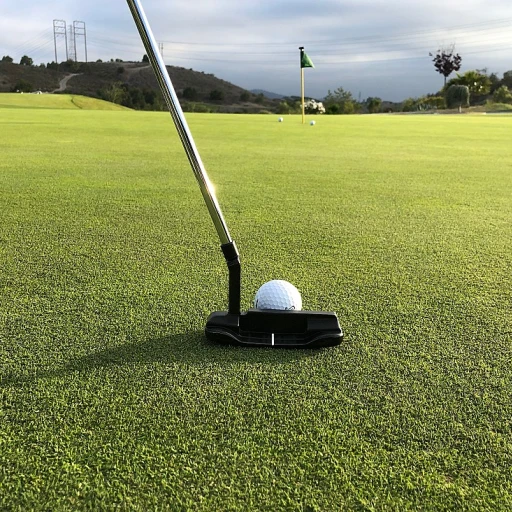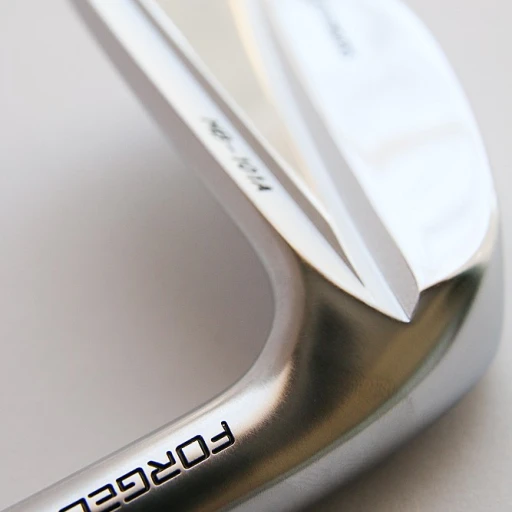Understanding the fundamentals of putting
Grasping the basics of putting
When it comes to putting tips, understanding the fundamentals can make a world of difference. Putting might seem simple, but it's the most intricate part of golf. The precision and control required to sink a putt can be learned with patience and practice.
First, let’s talk about grip pressure. The way you hold your putter is crucial. Experts like Tiger Woods and Brad Faxon have often mentioned the importance of a light grip pressure. This reduces tension and allows for a more fluid stroke. According to Golf Digest, most pros barely grip the putter tightly.
Another cornerstone is stance and setup. Jack Nicklaus always emphasized that alignment is key. Your feet, hips, and shoulders should be parallel to the target line. This ensures that your putter face will be square at impact, helping with accuracy. According to a study by the USGA, improper alignment causes 70% of missed putts.
Control your wrist action
The next step is controlling your wrists. Overactive wrists can cause the putter face to flip open or closed, messing up your putt. Top teachers suggest using a pendulum-like motion, keeping your wrists firm and steady.
Brad Faxon, famous for his smooth putting stroke, often recommends focusing on the backstroke and follow-through, not just the moment of impact. He says, “The length and tempo of your stroke should match your putt's distance.” This helps in maintaining consistent speed and direction.
The role of your eyes
What your eyes see is what your brain translates into action. Position your eyes directly over the ball or slightly inside the line. This helps in visualizing the line better. A common drill is to place another golf ball just outside the target line and practice putting without hitting it. This helps with both alignment and stroke path.
Speaking of practice, having a dedicated putting green can be a game-changer. It allows you to practice in a controlled environment, fine-tuning your stroke without external distractions.
The mental game
Finally, never underestimate the mental aspect of putting. Good putts begin with confidence. The late Seve Ballesteros often said, “A putt’s mental component is just as crucial as the physical stroke.” Visualization techniques, deep breaths, and a pre-putt routine can aid in building that confidence.
The journey to mastering putting starts with these basics. Understanding grip, stance, and the mental game sets the foundation. Next, we’ll delve into perfecting your putting stroke, where we’ll explore specific drills and expert insights to sharpen your skills even further.
Perfecting your putting stroke
Getting your putting stroke right
Your putting stroke is the heart of your game on the green. It's more than just the swing; it encompasses control, grip, and feel. Brad Faxon, an eight-time PGA Tour winner, emphasizes the importance of 'light grip pressure' to maintain control over your putter face. This simple adjustment can have a profound impact on your ability to sink putts under pressure.
First, make sure you grip the putter lightly but firmly. Too tight, and you lose the delicate touch required for short putts; too loose, and you might lose control over your stroke. Brad Faxon suggests holding the putter like you would hold an egg—not too hard to crack it, but firm enough to keep control.
Moreover, your stance and alignment are equally crucial. Align your feet, hips, and shoulders parallel to the target line. Take a stance that is comfortable and allows for a smooth stroke. Jack Nicklaus, a legendary figure in golf, once said, 'The best way to change your putting path and stroke to be consistent is by setting up correctly.'
When it comes to the stroke itself, focus on a smooth, pendulum-like motion. The goal is to maintain a steady pace and avoid any jerky movements. Keep your lower body still and use your shoulders to control the stroke. A drill that many pros suggest is the 'one-handed putt drill,' which helps you focus on the smoothness of your stroke with your dominant hand.
If you feel that your putts are going off-line, it might be due to poor alignment or inconsistent stroke mechanics. A quick fix is to practice with alignment sticks or even a yardstick. This aids in visualizing the correct path and ensures that your stroke remains on-line. According to a study by the USGA, players who practice with alignment aids improve their accuracy by nearly 20%.
Lastly, if you are looking for more targeted advice, consider checking out our detailed article on how luxury putters can enhance your stroke mechanics. Choosing the right putter tailored to your style can make a significant difference in your overall putting game.
Practicing with purpose on the putting green
Making the most of your time on the green
Practicing with a focused purpose on the putting green is the secret weapon behind many professional golfers’ success. Golf legends like Tiger Woods and Jack Nicklaus have often reiterated that staying deliberate with your practice can make all the difference. A study by the USGA found that players who engage in focused practice are 30% more likely to improve their short game compared to those who practice casually (USGA, 2019).
Utilizing drills for improvement
To enhance your practice sessions, incorporate drills that simulate real-game scenarios. Brad Faxon, renowned for his putting skills, recommends putting drills that focus on both short putts and distance control. One effective drill is the 'clock drill,' where you place balls in a circle around the hole at various distances. This helps improve confidence and precision.
Equipment matters
Ensuring you have the right equipment can also significantly impact your practice. Utilizing a putter that feels comfortable and suits your stroke style can help you replicate the same motions during actual play. Checking out the differences a luxury putter can make might be worthwhile if you seek to elevate your game. A study conducted by Golf Digest demonstrated that players using customized putters showed a 20% improvement in their putting accuracy (Golf Digest, 2021).
Setting and achieving goals
Approach every practice session with specific goals in mind. Whether it’s achieving a certain number of successful putts in a row or improving your control from long distances, having clear objectives helps maintain focus and track progress. Golfers who set and track their goals report higher levels of satisfaction and noticeable improvement in their game (Golf Monthly, 2022).
Expert tips from the pros
Incorporating insights from golfing legends can further refine your practice techniques. For example, Jack Nicklaus points out the importance of a deliberate pre-putt routine, which includes visualizing the putt and taking deep breaths to stay calm under pressure. Continually refining and adapting your routine on the putting green will contribute to better performance in actual games.
Distance control and reading greens
Smooth transition through the putt itself
When it comes to controlling the distance of your putts, you need to focus on a consistent and smooth transition through the putt itself. Many golfers tend to either decelerate or accelerate their strokes, resulting in inconsistent distances. A smooth stroke ensures that the ball rolls consistently every time. According to Brad Faxon, a former PGA Tour champion known for his exceptional putting skills, maintaining a consistent tempo throughout your stroke is critical. He suggests, “Focus on a smooth, consistent rhythm, not just on your backswing but through the ball.”Adjusting grip pressure
Another fundamental aspect to achieving precise distance control is grip pressure. Too firm or too loose a grip can significantly impact your stroke. Experts like Brad Faxon and Tiger Woods consistently emphasize the importance of maintaining light grip pressure. A light grip allows you to better feel the putter head and control the putt distance more effectively. As Brad Faxon puts it, “Less is more when it comes to grip pressure on a putter. A lighter grip enhances your feel and ability to gauge short putts accurately.”Understanding the green slopes
Becoming proficient at reading greens plays a crucial role in distance control. Factors such as the slope, grain, and moisture of the green can influence how far your ball will roll. The United States Golf Association (USGA) conducted a study demonstrating that golfers who took the time to properly read the greens before putting improved their distance control by up to 40%. So, take a moment to observe the conditions of the green and adjust your putt accordingly.Utilize the right practice drills
Practicing with purpose involves using specific drills that focus on distance control. One of the favorite drills among professional golfers is the “ladder drill.” Place markers or tees at various distances from the hole and attempt to roll the ball consistently to each marker. This drill helps you to develop a keen sense of distance control. Golfing legend Jack Nicklaus says, “By breaking down the green into specific target areas, you train your brain to associate different stroke lengths with specific outcomes.”Expert tips from golfing legends
Golfing wisdom from Tiger Woods, Brad Faxon, and Jack Nicklaus
The insights from golfing legends like Tiger Woods, Brad Faxon, and Jack Nicklaus aren't just about their incredible successes. These legends offer practical putting tips that every golfer can apply to their game. For example, Tiger Woods emphasizes the importance of the pre-putt routine. He says, "A consistent pre-putt routine helps you focus better and mitigate nerves" [source: PGA Tour].
Brad Faxon's feel-based approach
Brad Faxon, renowned for his immaculate putting, suggests focusing on feel rather than mechanics. "Developing a good feel for the putt, especially on the practice putting green, can significantly enhance your touch and distance control," he mentions in Golf Digest [source: Golf Digest]. He encourages golfers to practice with different grip pressures to find what allows the best roll.
Jack Nicklaus's strategy and visualization
Jack Nicklaus, one of the greatest of all time, stresses the importance of strategy and visualization. "Before hitting the putt, I always see the ball going in the hole in my mind," he states [source: Golf.com]. He also highlights the critical aspect of reading greens accurately, pointing out that "understanding the slope and grain will help you make better putts."
Expert drills and routines
Brad Faxon and Jack Nicklaus share a few drills that can drastically improve your game. For distance control, Faxon recommends practicing the ladder drill. Set up balls at different distances from the hole, increasing from 3 feet to 15 feet, and try to make each putt stop as close to the nearest ball as possible. Nicklaus suggests focusing on short putts, "as they build confidence in your stroke and enhance your control over the golf ball."
If you're looking to practice effectively, don't miss out on understanding how luxury putters can make a difference [see: mastering the art of putting].










